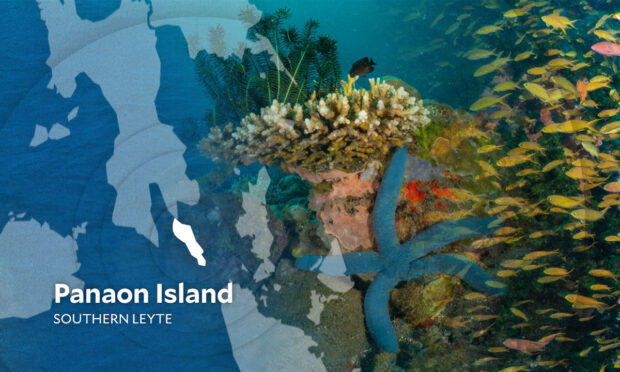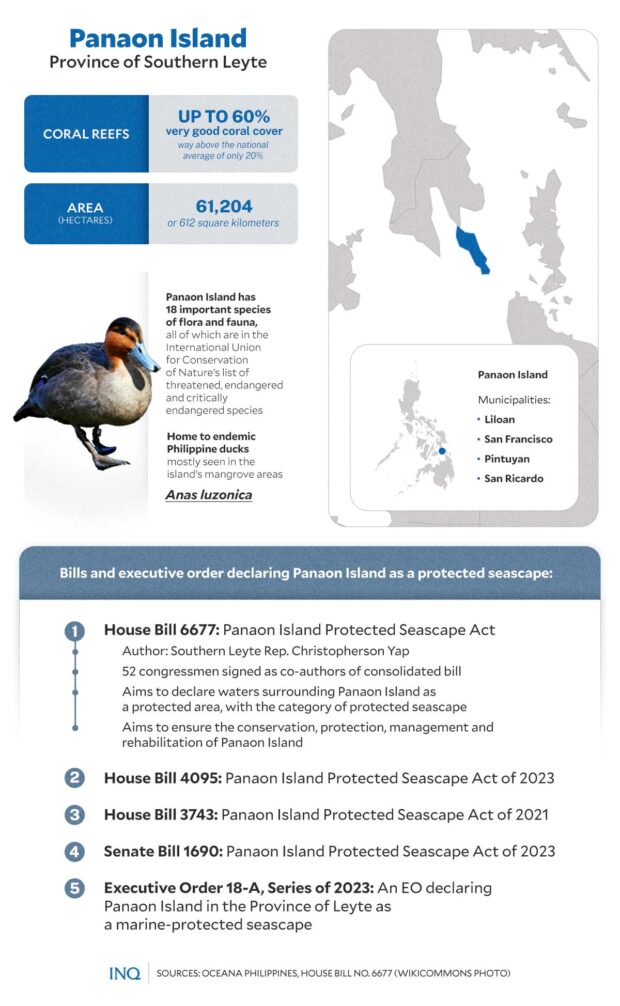Hope grows for protection of Panaon Island

COMPOSITE IMAGE FROM PHOTOS CONTRIBUTED BY DANNY OCAMPO, OCEANA
MANILA, Philippines—An international organization dedicated to protecting the world’s oceans lauded a bill declaring Panaon Island in Leyte as a protected seascape as it gained ground with the support of more members of the House of Representatives.
In a statement, international nongovernment organization Oceana and Southern Leyte Rep. Christopher “Coco” Yap, author of House Bill (HB) No. 6677 or the proposed Panaon Island Protected Seascape (PIPS) Act, expressed gratitude to the 52 other legislators, led by Speaker Ferdinand Martin Romualdez, who signed as co-authors of the bill.
“It is with deep pride and honor that our call for protection of this biodiversity gem of Panaon Island was well received by no less than the leadership of this chamber,” said Yap.
“We are looking forward to the passage of this bill soon, when the second regular session starts next month,” he said.
The bill, which is a revised version of HB No. 4095 or the proposed Panaon Island Protected Seascape (PIPS) Act of 2023 earlier filed by Yap, seeks to declare the island a protected area with the category of protected seascape pursuant to Republic Act (RA) No. 7586 or the National Integrated Protected Areas System (NIPAS).
Article continues after this advertisementAccording to RA 7586, protected seascapes refer to “areas of national significance which are characterized by the harmonious interaction of man and land while providing opportunities for public enjoyment through recreation and tourism within the normal lifestyle and economic activity of these areas.”
Article continues after this advertisementUnder HB No. 6677, a Protected Area Management Board (PAMB) will oversee the management of the proposed protected seascape.
The management board, which will be formed within 90 days from the enactment of the bill into law, will be composed of the Eastern Visayas director of the Department of Environment and Natural Resources (DENR), the governor of Southern Leyte, and others.
READ: Panaon Island Protected Seascape
“Oceana is very proud of the concerted efforts to move for the national protection of Panaon Island’s magnificent coral reefs,” said lawyer Rose Liza Eisma-Osorio, Oceana acting vice president and legal and policy Director.
“Protecting these climate resilient reefs and saving these coral reefs from the continuous threats that hound our marine resources will, in turn, provide food security and livelihood to so many Filipinos,” said Eisma-Osorio.

GRAPHIC Ed Lustan
She said the move would also be among the Philippines contribution “to the global effort to declare 30 percent of the planet’s water as marine protected areas by 2030.”
Last May 15, the House Committee on Natural Resources approved the consolidated bill for the proposed Panaon Island seascape pending submission of a minor revision to a technical description of the area by the National Mapping and Resource Information Authority (Namria).
Namria had submitted the revised technical description to the committee before the session ended on May 26.
Beauty and biodiversity
Panaon, a small island in the province of Southern Leyte, has an area of about 61,204 hectares or 612.04 square meters. It is home to over 50,000 people who depend mainly on harvesting coconut and fishing for their livelihood.
Panaon, a coral-rich paradise, forms part of the “Coral Triangle,” which was described by Oceana as “an area of high biodiversity that sprawls across multiple countries in the western Pacific Ocean.”
According to the organization, Panaon has up to 60 percent very good coral cover which is way above the national average of just 20 percent. This was considered by Oceana as a “welcome surprise” because of the steady degradation of Philippine coral reefs in the last 40 years.
READ: Artificial habitats: Not enough to save PH coral system
Panaon has more than 250 species of hard coral and soft corals.
“In one spot, you may see delicate sea fans, swathed in varying shades of yellow, orange, and pink. In another, you may come across table corals stretching five meters (16 feet) across, their umbrellas sheltering marine life in need of some shade,” Oceana said.
“There are fungi-like foliose corals, magenta-colored soft corals, and massive branching corals resembling the roots of an ancient tree,” it added.
The waters of Panaon Island are home to several marine species.
Yvette Lee, an award-winning photographer who had dived all over Asia, noted that corals in Panaon are in mint condition, which signified that it has not yet been heavily impacted by human activity.
“Panaon is a gem. It’s a 20-carat emerald,” said Lee, who was part of the Panaon expedition’s documentary team. “Only in rarely dived places can you see sea fans growing out of the sandy floor,” Lee said.
“Usually, you see them on walls or steep slopes. In Panaon, you see them a lot, which is an indication that it is a relatively untouched place where pristine reefs thrive,” Lee continued.
Aside from Panaon’s impressive coral reefs, the island also has mangroves that host endemic Philippine ducks (Anas luzonica).
There are also 18 important species of flora and fauna found in the waters surrounding the island—all of which are on the International Union for Conservation of Nature’s (IUCN) list of threatened, endangered, and critically endangered species that include whale sharks, blue whales, hawksbill turtle, and green sea turtle.
Ecotourism through sustainable whale shark interactions provides alternative livelihood to locals who are mostly fishers.
“For a coastal area like my district, food, economic, and job security are deeply tied to nature,” said Yap at a recent photo exhibit at the House showcasing Panaon.
“This is why it is crucial for us to do what is necessary to protect our seas, which allows us to continue to thrive and enjoy the very freedoms we enjoy as a democratic country,” he said.
“[This] area which we are seeking protection is also one of the best dive sites in the world and has the potential to generate green jobs once we can fully develop it into a sustainable tourism destination like our neighbor Siargao and Boracay,” Yap added.
Prevent future threats
Unfortunately, a team from Oceana that went on a 22-day expedition to Panaon in 2020 also discovered plastic pollution—plastics wrapped around corals. These are considered very dangerous, especially for sea turtles—a vulnerable species–which could ingest plastics or get entangled with these.
“Because sea turtles are unable to easily regurgitate foreign objects, swallowing a piece of plastic can be a slow death sentence if it prevents a turtle from eating or digesting food,” Oceana said
“Though marine pollution in Panaon is less prevalent than in other parts of the Philippines, it serves as a stark reminder that even seemingly pristine and remote habitats cannot escape the scourge of plastics,” it added.
Aside from marine pollution, Panaon faces other threats to its coral system.
“First, the island is an up-and-coming tourist destination and visitors could place undue strain on reefs that are already vulnerable to warming waters,” Oceana explained.
“Second, illegal and destructive fishing are widespread problems in the Philippines. Some fishers use dynamite and cyanide to catch fish. Others drag bottom trawls that bulldoze the seafloor. Corals, many of which are fragile, can take decades or longer to recover from destructive fishing,” it added.
Pass bills to protect Panaon
Oceana has been urging Congress to pass the bill declaring Panaon Island as a protected seascape to ensure that the island’s rich biodiversity is protected and preserved.
“We call for the urgency of the measure as we race against time in achieving the targets and more importantly, in preserving the integrity of the natural life support system that our coral reefs, mangroves, seagrasses, and wetlands provide,” Eisma-Osorio earlier said.
“The destruction of these invaluable havens for the people and wildlife persists and will get worse if we will continue to lay back and take our own sweet time taking action,” she added.
READ: Oceana: Declare Panaon Island a protected area
Ocena said the Philippines is tagged as one of the 17 mega-diverse countries in the world and, if sustainably protected, could help defend the planet against the impact of the climate crisis.
“We are running against time in protecting the biodiversity-rich areas in our country. These are our shield against the devastating impacts of climate change,” said lawyer Gloria Estenzo Ramos, Oceana vice president.
“Aside from the barrier these provide to our coastal communities when extreme weather conditions hit them, we are assured of enhancing the rich source of seafood and marine resources that the people of Panaon and other parts of the country can depend on for their food and nutrition,” Ramos added.
Aside from HB No. 6677 and 4095, other proposed measures have also been filed by other lawmakers seeking to declare Panaon as a protected seascape.
At the start of the 19th Congress, Rep. Luz Mercado, also of Southern Leyte, filed House Bill 3743 at the start of the 19th Congress.
Southern Leyte Gov. Damian Mercado also issued on March 16, 2023, Executive Order 18-A, series of 2023, declaring Panaon Island and all of its waters as a protected seascape.